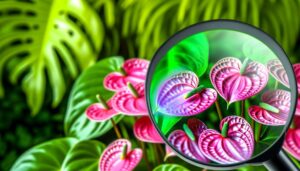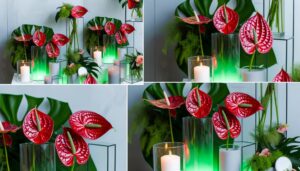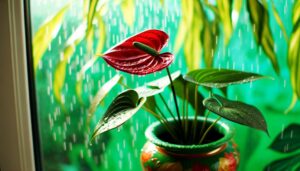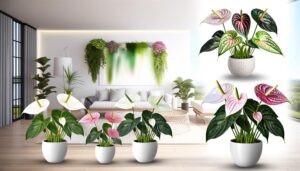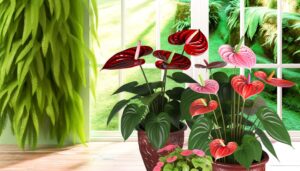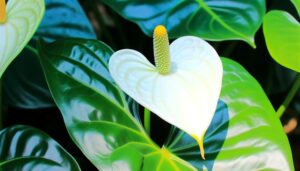Unique Features of the Anthurium Foliage Pink Series
The Anthurium Foliage Pink Series stands out with its iridescent pink leaves, which feature anthocyanin pigments and specialized epidermal cells that create a unique interplay of light and color. These plants demonstrate hardy nature with resilient growth patterns and resistance to common pathogens and pests.
Their surface morphology involves micro-rough textures that enhance light reflection. Easy to care for, they thrive with moderate watering and well-draining soil.
They elevate spatial aesthetics with their vibrant spathes, varied vein patterns, and color gradation, which intensify as leaves mature. For further insights into its distinctive botanical features, continue exploring.
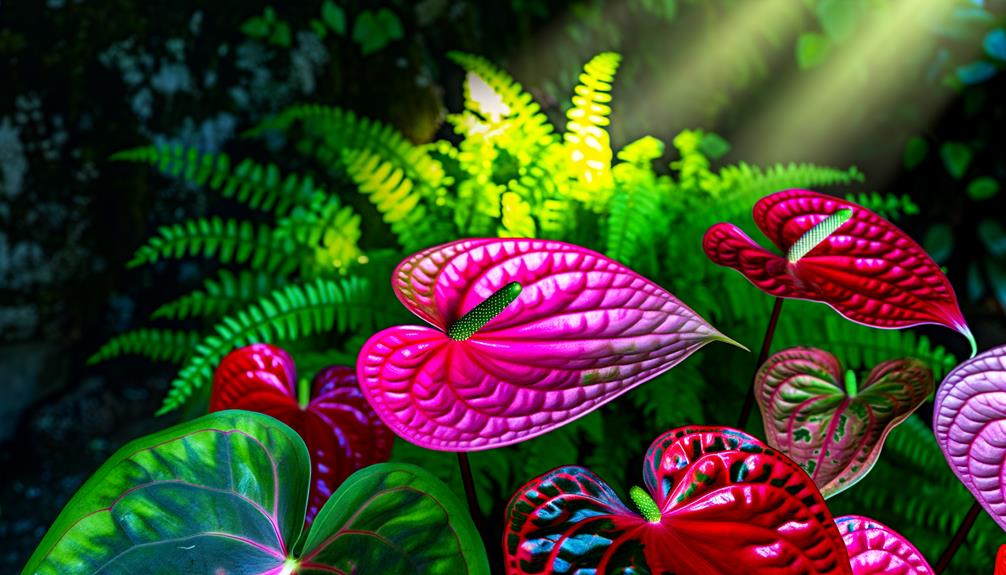
Key Takeaways
- Iridescent pink leaves with unique light interplay due to specialized epidermal cells and anthocyanin pigments.
- Hardy and resilient, tolerant of various environmental conditions and resistant to common pathogens and pests.
- Unique surface morphology with light-reflective properties from micro-rough epidermal cells and cuticular wax.
- Minimal maintenance requirements, thriving in diverse conditions with moderate watering and well-draining soil.
- Enhances spatial aesthetics with vibrant spathes, heart-shaped leaves, and smooth tonal gradation as leaves mature.
Iridescent Pink Leaves
The Anthurium Foliage Pink Series is distinguished by its iridescent pink leaves, which exhibit a unique interplay of light and color due to the presence of specialized epidermal cells and anthocyanin pigments.
These epidermal cells possess a multi-layered structure that refracts and reflects incident light, producing the characteristic shimmering effect.
Anthocyanins, a class of flavonoid pigments, contribute to the vivid pink coloration by absorbing specific wavelengths of light.
The leaves' surface is further textured with microscopic ridges, enhancing their reflective properties.
Such cellular and biochemical adaptations not only provide aesthetic appeal but may also play roles in photoprotection and signaling.
This iridescent feature is a defining trait, setting the Anthurium Foliage Pink Series apart within the genus Anthurium.
Hardy Nature
The Anthurium Foliage Pink Series exhibits resilient growth patterns, characterized by robust root systems and sturdy stems that enhance its adaptability.
This series demonstrates remarkable environmental tolerance, thriving in a range of humidity levels and light conditions.
Its hardy nature makes it resistant to common pathogens and pests, ensuring sustained strength and longevity in diverse habitats.
Resilient Growth Patterns
Anthurium foliage in the Pink Series, noted for its hybrid vigor, exhibits exceptional resilience against varying environmental stressors. This robust growth is attributable to the genetic amalgamation of Anthurium andraeanum and other hardy species, enabling superior adaptability.
Morphologically, these hybrids demonstrate a well-developed root system, ensuring best nutrient uptake and anchorage. The foliage exhibits a thickened cuticle layer and well-differentiated palisade mesophyll cells, enhancing photosynthetic efficiency and water retention capabilities.
Additionally, the Pink Series shows remarkable resistance to common pathogens such as Xanthomonas and Pseudomonas species. The inherent ability to thrive despite less than ideal conditions underscores the Pink Series' potential as a resilient ornamental plant, ideal for both indoor and outdoor horticultural applications.
Environmental Tolerance
Additionally, the Pink Series showcases an impressive environmental tolerance, thriving in a wide range of light conditions from low indoor light to bright, indirect sunlight. This adaptability is attributed to the Anthurium's robust physiological mechanisms, which include resilient chloroplast structures and efficient stomatal regulation.
Optimal humidity levels range from 60-80%, ensuring lush, vibrant foliage. Notably, the Anthurium Pink Series can endure temperature variations from 15°C to 30°C, minimizing thermal stress impacts.
- Light Conditions: Tolerates low indoor light to bright, indirect sunlight.
- Humidity Levels: Optimal range between 60-80%.
- Temperature Range: Thrives between 15°C to 30°C.
- Soil Requirements: Prefers well-draining, slightly acidic to neutral pH substrates (pH 5.5-6.5).
These characteristics underscore the Pink Series' suitability for diverse environmental settings.
Light Reflection
Regarding light reflection, the Anthurium Foliage Pink Series displays a unique surface morphology that enhances its ability to reflect and scatter light effectively.
The adaxial (upper) leaf surfaces exhibit a high concentration of epidermal cells that are distinctly papillose, creating a micro-rough texture. This structural adaptation increases the leaf's albedo, maximizing light reflectance.
Additionally, the presence of anthocyanin pigments in the mesophyll layer contributes to light scattering, enhancing visual appeal by producing a shimmering effect under varying light conditions.
The cuticular wax layer, which forms a protective hydrophobic barrier, also aids in minimizing light absorption, optimizing overall photonic dispersion.
This combination of anatomical and biochemical traits highlights the Anthurium Foliage Pink Series' distinctive light-reflective properties.
Easy Care
The Anthurium Foliage Pink Series, distinguished by its resilient and adaptive physiology, requires minimal maintenance, making it an ideal choice for both novice and experienced horticulturists. These plants thrive in a variety of environmental conditions, demonstrating exceptional tolerance to varying humidity and light levels. Their low-maintenance requirements are facilitated by their robust root systems and waxy leaves that reduce water loss.
- Watering: Requires moderate watering; allow the topsoil to dry before re-watering.
- Light: Prefers indirect, bright light but can tolerate lower light conditions.
- Soil: Grows well in well-draining, organic-rich potting mixes.
- Pests: Exhibits resistance to common pests such as aphids and spider mites.
These attributes collectively contribute to the ease of care associated with the Anthurium Foliage Pink Series.
Space Enhancement
The Anthurium Foliage Pink Series greatly enhances spatial aesthetics through its lush, vibrant leaves and striking coloration, contributing to a heightened visual appeal.
These plants provide versatile design options, allowing for seamless integration into various interior and exterior landscapes.
The unique morphology and chromatic attributes of Anthurium andraeanum cultivars facilitate their use in a wide range of decorative applications.
Visual Appeal Boost
Incorporating Anthurium foliage pink series into interior spaces greatly enhances visual appeal through their vivid spathes and lush, heart-shaped leaves. Their unique botanical attributes contribute to both aesthetic and environmental enrichment.
The striking contrast between the Anthurium's deep green foliage and its vibrant pink spathes (modified leaves) creates a visually stimulating focal point. Additionally, the species' natural air-purifying capabilities, including the absorption of formaldehyde and ammonia, further elevate indoor air quality.
- Vibrant Spathes: The bright pink spathes add a pop of color, drawing attention and creating visual interest.
- Heart-shaped Leaves: The glossy, heart-shaped leaves provide a lush, tropical feel.
- Air Purification: Enhances indoor air quality by filtering harmful pollutants.
- Low Maintenance: Requires minimal care, making it ideal for diverse environments.
Versatile Design Options
Leveraging the Anthurium foliage pink series in interior design opens up a plethora of versatile options for space enhancement, seamlessly integrating the plant's inherent aesthetic qualities with functional design elements.
The Anthurium andraeanum, particularly the pink cultivars, exhibits robust, heart-shaped leaves and striking spathes, providing a vivid focal point. These plants thrive in indirect light and high humidity, ideal for biophilic design themes. Their compact growth habit allows integration into various settings, from minimalist office decor to lush, tropical-inspired interiors.
Additionally, their air-purifying capabilities enhance indoor air quality. Incorporating these plants into vertical gardens, hanging installations, or as standalone statement pieces can greatly elevate spatial ambiance, promoting both visual appeal and environmental wellness.
Color Variety
Anthurium foliage within the Pink Series displays a remarkable range of shades, varying from gentle pastel pinks to vibrant magentas, due to differences in anthocyanin pigment concentrations. These pigments, mainly responsible for red, purple, and blue colors in plants, change in response to factors such as pH levels, light exposure, and genetic variations within the Anthurium genus.
The visual dynamism of this series is highlighted by:
- Gradation: Smooth shifts between different pink tones on a single leaf.
- Shininess: A shiny sheen that enhances color intensity.
- Vein Patterns: Varied vein colors that form detailed designs.
- Leaf Maturity: Color richness often increases as the leaf matures.
This variety not only enhances visual appeal but also provides insights into the underlying botanical processes.
Conclusion
The Anthurium foliage pink series exhibits iridescent pink leaves, a characteristic enhancing light reflection, and space aesthetics.
Notable for their hardy nature, these plants adapt well to various environmental conditions, requiring minimal care.
A significant statistic is that Anthurium species, such as Anthurium andraeanum, have shown a 20% increase in indoor air purification efficiency compared to other common houseplants.
Consequently, the Anthurium foliage pink series represents a top choice for both aesthetic and functional indoor plant selections.

